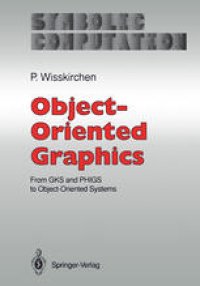
Ebook: Object-Oriented Graphics: From GKS and PHIGS to Object-Oriented Systems
Author: Dr. Peter Wisskirchen (auth.)
- Tags: Computer Graphics
- Series: Symbolic Computation
- Year: 1990
- Publisher: Springer-Verlag Berlin Heidelberg
- Edition: 1
- Language: English
- pdf
At present, object-oriented programming is emerging from the research labora tories and invading into the field of industrial applications. More and more products have been implemented with the aid of object-oriented programming techniques and tools, usually as extensions of traditional languages in hybrid development systems. Some of the better known examples are OSF-Motif, News, Objective-C on the NeXT computer, the C extension C++, and CLOS an object oriented extension of LISP. All of these developments incorporate interactive graphics. Effective object-oriented systems in combination with a graphics kernel does it mean that the field of computer graphics has now become merely an aspect of the object-oriented world? We do not think so. In spite of interesting individual developments, there are still no sound object-oriented graphics sys tems available. If it is desired to develop a complex graphics application embed ded in a window-oriented system then it is still necessary to work with elemen tary tools. What is to be displayed and interactively modified inside a window must be specified with a set of graphics primitives at a low level, or has to be written with a standardized graphics kernel system such as GKS or PHIGS, i. e. , by kernels specified and implemented in a non-object-oriented style. With the terms GKS and PHIGS we enter the world of international graphics standards. GKS and PHIGS constitute systems, not mere collections of graphics primitives.
This book covers computer graphics programming on the basis of an object-oriented philosophy and using the object-oriented programming paradigm. It shows how a thorough investigation of object-oriented techniques leads to very powerful and flexible graphics systems, which are in sharp contrast to traditional systems such as GKS and PHIGS. An object-oriented multi-level-system system GEO++ with full editing capabilities is defined as a basis for detailed examples using Smalltalk-80 language. The advantages of inheritance are shown for a flexible extension of a predefined graphics kernel. New ways of integrating geometric modeling aspects and defining new output primitives into a prefabricated kernel are demonstrated. Prerequisites for adding rules and constraints are discussed. Requirements for a new object-oriented standard are formulated. A significant part is devoted to detailed examples, showing the progress which can be achieved with a consistent object-oriented approach. Rather than reviewing all different object-oriented approaches and prototypical developments, the book builds a bridge between traditional graphics programming systems and the object-oriented approach. The book is intended for computer scientists and programmers seeking to become familiar with graphics systems and object-oriented programming.
This book covers computer graphics programming on the basis of an object-oriented philosophy and using the object-oriented programming paradigm. It shows how a thorough investigation of object-oriented techniques leads to very powerful and flexible graphics systems, which are in sharp contrast to traditional systems such as GKS and PHIGS. An object-oriented multi-level-system system GEO++ with full editing capabilities is defined as a basis for detailed examples using Smalltalk-80 language. The advantages of inheritance are shown for a flexible extension of a predefined graphics kernel. New ways of integrating geometric modeling aspects and defining new output primitives into a prefabricated kernel are demonstrated. Prerequisites for adding rules and constraints are discussed. Requirements for a new object-oriented standard are formulated. A significant part is devoted to detailed examples, showing the progress which can be achieved with a consistent object-oriented approach. Rather than reviewing all different object-oriented approaches and prototypical developments, the book builds a bridge between traditional graphics programming systems and the object-oriented approach. The book is intended for computer scientists and programmers seeking to become familiar with graphics systems and object-oriented programming.
Content:
Front Matter....Pages I-XIII
Introduction....Pages 1-18
Object-Oriented Concepts....Pages 19-52
Object-Oriented Interface Architecture....Pages 53-74
Smalltalk-80 Graphics Kernel....Pages 75-82
GKS and Object-Oriented System Design....Pages 83-101
Graphics Part Hierarchies....Pages 102-110
PHIGS and Part Hierarchies....Pages 111-118
GEO++....Pages 119-147
Programming Examples....Pages 148-177
Using Inheritance....Pages 178-195
Prototypes and Delegation....Pages 196-200
GEO++ in Smalltalk-80....Pages 201-206
Additional Concepts and Tools....Pages 207-220
Towards an Object-Oriented Standard?....Pages 221-227
Back Matter....Pages 229-236
This book covers computer graphics programming on the basis of an object-oriented philosophy and using the object-oriented programming paradigm. It shows how a thorough investigation of object-oriented techniques leads to very powerful and flexible graphics systems, which are in sharp contrast to traditional systems such as GKS and PHIGS. An object-oriented multi-level-system system GEO++ with full editing capabilities is defined as a basis for detailed examples using Smalltalk-80 language. The advantages of inheritance are shown for a flexible extension of a predefined graphics kernel. New ways of integrating geometric modeling aspects and defining new output primitives into a prefabricated kernel are demonstrated. Prerequisites for adding rules and constraints are discussed. Requirements for a new object-oriented standard are formulated. A significant part is devoted to detailed examples, showing the progress which can be achieved with a consistent object-oriented approach. Rather than reviewing all different object-oriented approaches and prototypical developments, the book builds a bridge between traditional graphics programming systems and the object-oriented approach. The book is intended for computer scientists and programmers seeking to become familiar with graphics systems and object-oriented programming.
Content:
Front Matter....Pages I-XIII
Introduction....Pages 1-18
Object-Oriented Concepts....Pages 19-52
Object-Oriented Interface Architecture....Pages 53-74
Smalltalk-80 Graphics Kernel....Pages 75-82
GKS and Object-Oriented System Design....Pages 83-101
Graphics Part Hierarchies....Pages 102-110
PHIGS and Part Hierarchies....Pages 111-118
GEO++....Pages 119-147
Programming Examples....Pages 148-177
Using Inheritance....Pages 178-195
Prototypes and Delegation....Pages 196-200
GEO++ in Smalltalk-80....Pages 201-206
Additional Concepts and Tools....Pages 207-220
Towards an Object-Oriented Standard?....Pages 221-227
Back Matter....Pages 229-236
....